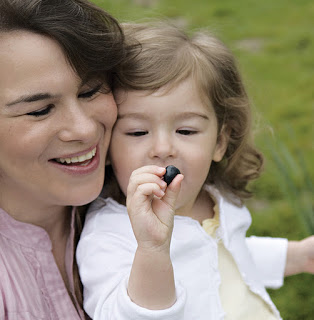By Hannah Richards
Before I became a parent I always used to shake my head at the kids menu at local restaurants. Macaroni and Cheese, Grilled Cheese, Pasta with Butter and Cheese, Cheese with Added Cheese… you get the idea.

Now, as a parent, I totally get it. That’s pretty much all toddlers will eat: carbs and cheese. And at a restaurant, where you’re already expending every last drop of caffeine-induced energy keeping your kid from crawling into the kitchen and turning all the stove dials, or playing tic-tac-toe in pen on the white tablecloth – I say let ‘em have whatever they want. Take the path of least resistance. Just be thankful they’re eating something. Unless it’s crayons. In which case, no.
But when you’re at home, and you have access to earplugs for the screeching meltdown that will inevitably ensue when you tell them that, no you cannot have French fries for breakfast – that’s when you pull out all the stops to get them to eat something with at least a semblance of nutritional value.

Now, if your toddler is anything like mine, they won’t eat more than one or MAYBE two foods per meal. You put three or more ingredients on the tray and she is O-U-T out. Or in her words, “All gone mama,” which is ironic considering all of her food is literally untouched.
Because of this I’ve learned to be extremely efficient. I’ve chosen a number of well-known superfoods like Wild Blueberries, kale, beans, and yogurt – all of which are packed with vitamins and nutrients – and devised sneaky strategies for including them in foods she thinks are fun. Then I try to contain my (probably disproportional) excitement as I watch her toss back a – gasp! – fruit or vegetable without knowing it.


So without further ado – my four favorite toddler-friendly superfood snacks.
- Wild Blueberry, Banana and Kale Smoothie

In my opinion smoothies are far and away the easiest way to get nutrients into toddlers. My daughter Mia is absolutely enamored with straws, so I can pretty much put anything I want into a blender and as long as she’s allowed to drink it through a straw, she’s excited. This recipe is my favorite because it uses frozen kale (fresh veggies are always going bad in our fridge so frozen kale is PERFECT) and frozen Wild Blueberries, which not only completely mask the color and flavor of the kale, but are also full of antioxidants, fiber, and manganese, which is essential for healthy bone development. I use Wild Blueberries in just about every smoothie we make because they are nutrient-rich, and the perfect vegetable-disguiser!
Ingredients:
½ cup frozen kale
¼ cup Wild Blueberries
¾ cup milk (you can also use almondmilk, coconut milk or any other non-dairy milk)
½ medium banana
Directions: Blend all ingredients until smooth. If you use a frozen banana, you may need to add a little water to thin it out. Makes about 2 servings depending on your toddler’s appetite. I refrigerate the extra for use later in the week.
- White Bean Macaroni and Cheese

Mac and Cheese is a staple in our household. I keep some in the fridge pretty much at all times, in case all else fails. But since Mia ends up eating it SO often, I felt like I should try to get at least something substantive into it. Spinach is a no-go because it’s green and she can see it. Way too easy to for her to pick out! Then I found this recipe online that substitutes cannelloni beans and skim milk for the traditional whole milk and cream, and I thought – that’s genius! Sure enough, Mia can’t see or taste the difference – and to be honest, neither can I, so it’s perfect for the whole family.
- “Spoonable” Fruit and Yogurt

Ok so this isn’t so much a recipe as it is a strategy for getting healthy food into a stubborn toddler’s mouth. I found this “Easy Squeezy Spoon” at Babies R Us when Mia was just starting solids – and I thought it would be perfect for traveling with baby food. It probably is but I’ll never know because it disappeared into the abyss of my kitchen cabinets, never to be found until last week. I pulled it out to try and low and behold – Mia’s a big fan! She loves being able to squeeze the food onto the spoon herself (she hasn’t quite mastered traditional spoon feeding), and since she’s able to do it all on her own, she doesn’t even mind the pureed fruit and yogurt I stuffed into the squeeze pouch. Score!
Do you have a finicky eater on your hands? What are your favorite recipes or tricks for getting them to eat healthier?
Hannah Richards is a Maine based writer, blogger and content marketing strategist as well as the face behind the Facebook posts for Wild Blueberries. She lives with her husband, Dan, and daughter, Mia, in Cumberland, Maine and shares the crazy train they call motherhood on her blog OhBabyRichards.











